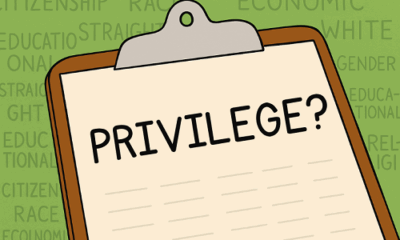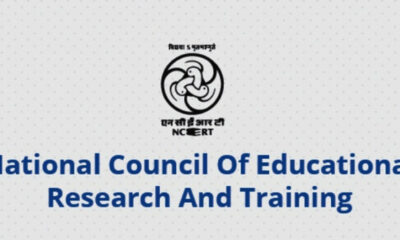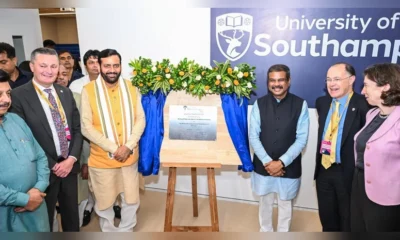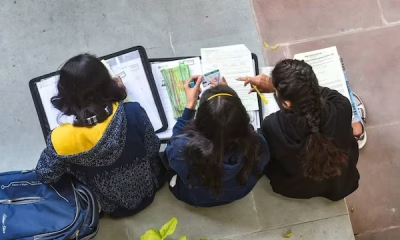Opinion
The Lockdown: Great Learning Opportunity For Educators
A Principal shares her views on the present situation of lockdown

As the entire world is in a state of lockdown, the wave of turmoil, fear, and anxiety has swept the entire global village. The uncertainty of what the future holds has affirmed that it will no longer be the same for all. The same unknown reorientation and change await education as well. In this chaotic scenario of the rise of the pandemic, schools have become suddenly unguarded places for young minds.
However, teachers, children and their parents are dealing with this situation from a more optimistic and positive lens. We perceived it quickly that schools may have shut abruptly, but not the minds of our children. Hence, learning must continue. The centre of learning was shifted from schools to their homes, the primary natural environment of every child.
Home is a composite of people living together in a family. This time where people are bound to stay at home, it gives everyone ample time to bond with their family which tends to be neglected in our routine life. Having meaningful times together with no urgency to reach someplace, helps create a series of memories and happiness to rejoice.
Families often indulge themselves in reliving past events of joy and contentment through old stories and photographs. This helps in keeping a consistently positive environment for children as well. Parents have also taken an initiative of homeschooling and took this opportunity to make household chores more fun and playful by involving kids and teaching them the errands of daily life.
Having said that, schools have taken up the responsibility to enable students to acquire knowledge, skills and competency required for decision making, problem-solving and collaboration. Thereby, the transition from classroom teaching to virtual learning has not only been challenging for all the stakeholders but also energizing and inspiring.
We are quite fortunate to be living in an era where technology is abundantly available and the wealth of resources for e-learning is plentiful. Many web platforms such as Google Classroom, Zoom, Hangout and Microsoft Team have smoothened the process of communication for education. Hence, presently, technology has metamorphosed into an important tool for teachers to impart education seamlessly. Technology, to educators, has proven to be an unfathomed window of opportunities.
In addition, to live in harmony with nature is probably the biggest lesson that this lockdown has taught us. Let us take this opportune moment to regain our connections and savour our relationship with Mother Earth. The list of to-dos is never-ending – there is so much to learn and do with our time in abundance. Let us, as educators, take our steps towards sensitizing our students and stakeholders towards the environment to move towards a brighter beginning.

Manju Rana: Principal/Director, Seth Anandram Jaipuria School (Ghaziabad)
Knowledge
Building a Healthier India: Why School Health Programs Are Essential
A developed India by 2047 requires more than economic growth; it requires human capability. Currently, the “last mile” of India’s healthcare system is missing—and it’s located in our schools. While the National Education Policy (NEP 2020) mandates health programs, the reality is a complete absence of trained health educators. By transforming schools into hubs of practical health skills, we do more than teach vitamins—we create a “child-to-parent bridge” that carries wellness back into the home, breaking intergenerational cycles of malnutrition and sedentary lifestyles for good.
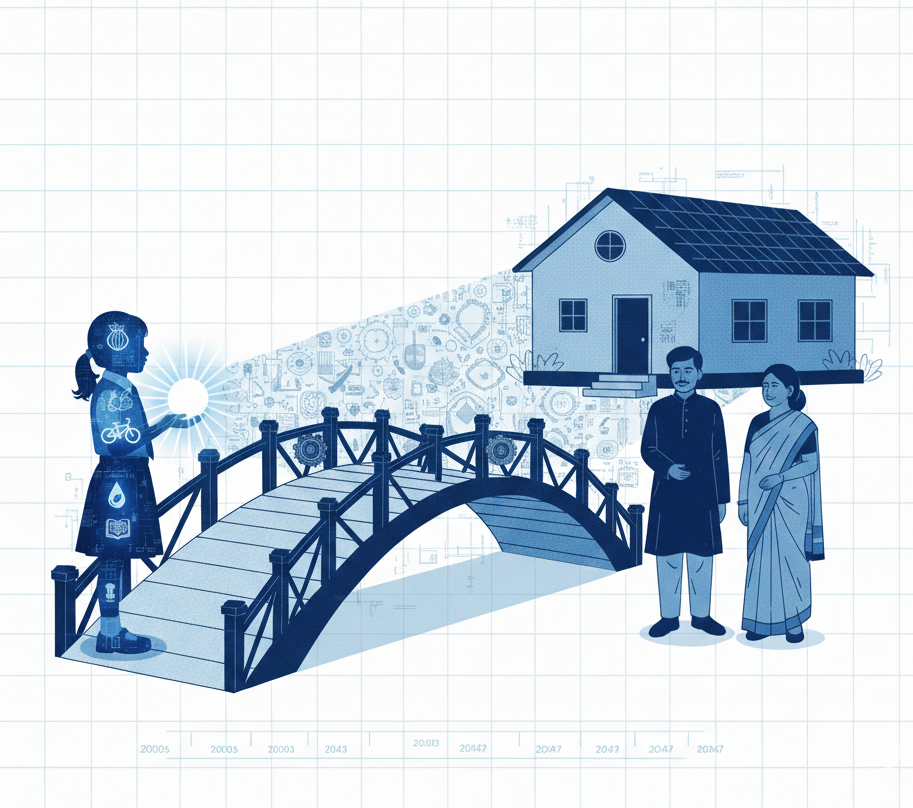
India’s ambition to become Viksit Bharat by 2047 sounds inspiring in political speeches. But here’s the uncomfortable reality: we can’t build a developed nation on the backs of an unhealthy population. And right now, we’re not doing well on that front.
Our average life expectancy has climbed to about 70 years—a genuine achievement. But dig deeper and you’ll find a troubling statistic: our healthy life expectancy is only 58 years. That means the average Indian spends their final 12 years managing poor health or living with disability. We’ve gotten better at keeping people alive longer, thanks to medical interventions. But we haven’t figured out how to keep them healthy. There’s a crucial difference.
The conventional approach to fixing this would be to focus on treating adults—better hospitals, more clinics, improved chronic disease management. But research tells us this is backwards. By the time someone is an adult struggling with diabetes or heart disease, you’re fighting an uphill battle.
Why Childhood Matters More Than We Think
Here’s what the science shows: health behaviors established in childhood act as a blueprint for adult life. The habits formed during our first two decades are significantly more resistant to change than those we pick up later. Think about it—how many adults do you know who’ve successfully transformed their relationship with food or exercise after decades of poor habits? It’s possible, but rare. The window of opportunity is childhood, and there are only two environments that really matter: home and school.
The Home Environment: When Parents Can’t Model What They Don’t Have
Children are mimics. They absorb far more from what they observe than from what we tell them. A parent who goes for morning runs or plays weekend cricket teaches their child that movement is normal and enjoyable. A sedentary parent who spends evenings on their phone? They’re teaching too, just a different lesson.
The same pattern holds for nutrition. Research from the World Health Organization shows that parental practices—what goes in the shopping cart, what sits on the dinner table—are among the strongest predictors of a child’s nutritional status. Children of parents who eat fruits and vegetables tend to follow suit. Those whose parents reach for processed foods and sugary drinks learn to do the same.
But here’s where things get difficult.
Data from the National Family Health Survey reveals that only about 28 percent of Indian adults eat what’s considered a balanced diet—all five major food groups daily. Fewer than half meet the global guideline of 150 minutes of moderate physical activity per week. Many parents actively discourage their children from playing sports or being physically active, pushing them toward extra study time instead. And approximately 40 percent of Indian men use tobacco in some form.
This isn’t about blaming parents. Most are doing their best with the knowledge and resources they have. But the data is clear: many Indian parents can’t model healthy behaviors because they haven’t developed them themselves.
Which brings us to schools.
Schools as the Missing Link
If we can’t rely solely on homes to teach healthy habits, schools become critical. The National Education Policy (NEP 2020) has recognized this by making school health programs mandatory and prioritizing holistic student development. Good policy on paper—but implementation is everything.
For a school health program to work in India, it needs to be skills-based, not just theoretical. Don’t just teach what vitamins are. Teach how to choose a healthy snack at the canteen. Don’t lecture about hygiene. Make sure the school has clean toilets and safe drinking water. Practice what you preach.
The benefits of getting this right extend far beyond the individual student.
First, obviously, students learn skills to improve their own health immediately. Second—and this is where it gets interesting—when these students eventually become parents, they’ll be far better equipped to raise healthy children themselves. Studies show that a mother’s education is more effective at preventing child stunting than household wealth alone. Educated mothers are 25 percent more likely to have non-stunted children because they understand exclusive breastfeeding, timely complementary feeding, immunization schedules. School health programs can break the intergenerational cycle of malnutrition.
Third, there’s what researchers call the “child-to-parent bridge.” Children can be remarkably effective change agents in households. A child who learns about nutrition in school will often come home and demand healthier foods, influencing what parents buy. When homework involves cooking a healthy meal with a parent, both learn. Schools should also run health seminars for parents—even if attendance is spotty, some education is better than none. Online options can help too.
The Infrastructure Gap: We Don’t Have Health Teachers
Here’s a problem: India currently has no trained health education teachers. Not a shortage—an absence. To make school health programs work, we need to establish training programs and certification systems. Most developed countries have had these for decades. We’re starting from scratch.
These school health educators would work alongside existing programs—the Anganwadis and ASHA workers who are already embedded in communities. But they’d fill different gaps. Anganwadis focus on early childhood, primarily birth to three years. They provide crucial health counseling and developmental tracking. ASHA workers are the frontline health activists facilitating vaccines, medications, and hospital visits. Both do important work, but they’re community-based and focused on medical tasks.
School health educators would operate in a structured learning environment. Once a child enters primary school, the intensive Anganwadi tracking often drops off. School educators can pick up that thread and extend it through age 18. And here’s the key difference: parents might follow ASHA workers’ instructions about medical “to-dos,” but they don’t necessarily internalize the science behind healthy habits. When health is taught as a formal subject in school, it carries intellectual weight. It bridges the gap between “knowing what to do” and “understanding why it matters.” Think of it this way: in parents’ minds, the Anganwadi is “the helper for my baby,” the ASHA worker is “the person for medicine,” and the school health educator could become “the teacher for my child’s future.”
Getting This Right Matters
The model that makes sense for India is integrated: Anganwadis continue handling ages zero to three, schools provide mandatory health literacy from six to eighteen, with periodic parent education built in. Each piece complements the others. This isn’t a small undertaking. It requires investment in teacher training, curriculum development, and ongoing program support. But consider the alternative: continuing to spend the final years of our lives managing preventable chronic diseases, watching productivity and quality of life decline, falling short of our potential as a nation.
School health programs represent what you might call the “last mile” of health education. We’ve built the healthcare infrastructure. We’ve created community health worker programs. But without embedding health literacy into the formal education system, we’re leaving a critical gap unfilled.
Viksit Bharat by 2047 isn’t just about economic growth or infrastructure development. It’s about human capability and wellbeing. And that foundation gets built in childhood, one healthy habit at a time.
About the Author:

Dr. Rahul Mehra is the National Representative of India for the UNESCO Chair for Global Health & Education and serves as the Executive Chairman of Tarang Health Alliance. He is a prominent advocate for health education, emphasizing the need for comprehensive health education in schools to address mental health, emotional well-being, and social skills.
Education
How to Build Better Parent-Teacher Communication

Good communication between parents and teachers plays an important role in a child’s learning and confidence. When both stay connected, it helps students feel encouraged and understood. Still, it’s not always easy to keep that connection strong. Busy schedules and small misunderstandings can make things tricky. The good news is that a few simple habits can make a real difference. Let’s examine what parent-teacher communication truly entails and how both parties can collaborate more effectively.
What is Teacher and Parent Communication?
Teacher and parent communication is all about staying connected and working together for a child’s growth. It’s not just a one-time meeting or message but a continuous, two-way exchange of updates, ideas, and feedback. When teachers and families stay in touch regularly, it creates a strong support system that helps students do better both in and outside the classroom.
In simple terms, teachers share what’s happening at school, like:
- Homework and assignments
- Grades and test results
- Class activities and behavior updates
- Social and emotional progress
- Strengths and areas where a student might need extra help
At the same time, parents share what’s happening at home, such as:
- How the child feels about schoolwork
- Any challenges or changes they’ve noticed
- Questions or suggestions about learning support
When both sides keep the communication open, it builds trust and teamwork. Teachers understand students better, and parents feel more involved in their child’s education.
Tips for Smooth Parent-Teacher Communication
Talking to parents doesn’t have to feel formal or uncomfortable. In fact, the better your connection with them, the smoother your teaching journey becomes. Whether you’re reaching out for the first time or trying to keep the conversation going, here are some real-world ways to build trust and keep communication easy, clear, and helpful.
1. Begin with a Friendly Introduction
Right at the beginning of the academic year, take a moment to introduce yourself to parents. You can send a friendly email, a printed note, or even a short video message. Let them know who you are, what you’re excited about, and how they can reach you. This early step breaks the ice and helps parents feel welcome and included in their child’s learning journey. When you set a positive tone early, it makes future communication easier and more comfortable for everyone.
2. Communicate Often, Not Just When There’s a Problem
Don’t let communication only happen during parent-teacher conferences or when something goes wrong. Send regular updates about what’s happening in class, upcoming events, or even small successes their child has had during the week. These don’t need to be long messages. A quick note about a student’s progress or behavior can make a parent’s day and help build trust over time. It also shows that you’re not just reaching out when there’s a problem.
3. Invite Their Voice, Too
Sometimes we forget that parents know their child better than anyone else. Ask questions. How does their child learn best at home? Are there any routines or challenges you should know about? And when they speak, listen fully. These conversations often reveal things that can shape how you teach and connect with the student.
4. Be Available and Approachable
Parents need to know that they can come to you when something is on their mind. That doesn’t mean being available 24/7, but it does mean creating space for honest conversations. You can let them know about your preferred times for calls or meetings, and also offer virtual options if in-person isn’t possible. Make sure the tone of your communication is always warm and non-judgmental so they feel safe speaking up.
5. Treat Parents as Team Members, Not Outsiders
Instead of just delivering information, try to involve parents as partners in their child’s learning. Share ideas for how they can help at home, ask for their observations, and thank them for their efforts. If there’s a behaviour issue or academic challenge, work with them on solutions instead of just reporting the problem. A strong home-school partnership creates a consistent support system for the student, both inside and outside the classroom.
6. Show Cultural Awareness and Respect
Families come from many different backgrounds, and their expectations may vary. Take the time to learn about their culture, language preferences, and family structure. Avoid making assumptions or using language that might feel exclusive. If needed, provide translations or simplify your communication to make sure everyone understands. This small effort shows parents that you value who they are and where they come from.
7. Share Progress in a Way That’s Clear and Supportive
Progress updates should be balanced. Yes, it’s important to point out what’s not working, but don’t forget to highlight what is. Give specific examples instead of vague praise or criticism. Say things like, “I’ve noticed Priya really lights up during science experiments,” or “Rohan is still working on staying focused during group tasks.” This kind of feedback feels personal and helps parents understand the full picture.
8. Choose the Right Tools for the Right Message
Too many apps or tools can overwhelm parents quickly. Choose one or two that you’ll stick to, whether it’s a school app, WhatsApp group, or weekly email. Use them for quick updates, reminders, or sharing student wins. Keep your tone casual but clear. Tech is helpful only when it makes life easier for both sides.
9. Respect Their Time and Yours
Teachers and parents are both juggling busy schedules. Respecting each other’s time helps keep communication productive and stress-free. If you’re scheduling meetings, offer time slots that work for working parents, too. Keep conversations focused so that meetings don’t run longer than necessary. Also, set clear boundaries about when you’re available.
When Is Parent-Teacher Communication Most Important?
Parent-teacher communication matters most right at the start of preschool. That first day of preschool is a big moment for every child and their family. When teachers and parents talk openly from day one, it helps everyone feel more comfortable and sets up a strong partnership for the rest of the year.
Why It Matters on Day One
- The first day of preschool often brings a mix of excitement and nervousness for both kids and parents. Honest communication helps everyone feel a little more comfortable.
- Open communication lets teachers learn about each child’s background, interests, and any worries or comforts. This way, teachers can give more personalized care and support from the beginning.
- Early conversations help build a sense of trust between home and school, making the classroom feel like a safe and welcoming place for the child.
- When teachers share classroom routines and expectations with parents on the first day, it helps families get ready and feel involved in their child’s new experience.
- These early talks also give teachers helpful details, like which languages are spoken at home, special family traditions, or any recent changes in the child’s life. This helps teachers communicate better and offer the right kind of support.
By making communication a priority from the very first day, both teachers and parents can work together to help each child settle in smoothly and feel confident as they start their schooling journey. Building strong parent-teacher teamwork not only supports a child’s emotional well-being but also lays the foundation for long-term academic success.
Closing Thoughts
We hope these tips help make your conversations with parents smoother and more meaningful. Building that connection takes time, but small efforts can lead to strong partnerships.
This article is authored by-
Chitra Khanna,
Content Strategist,
KLAY Preschools & Daycare
Education
Empowering Young People to Champion Neuro-Inclusion
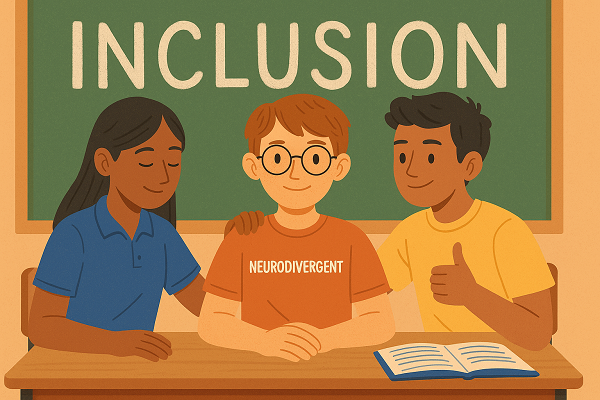
Aamir Khan’s recent film Sitaare Zameen Par has brought neurodiversity into the mainstream, and sparked important conversations about inclusion and rethinking what we consider ‘normal’. These cultural moments help raise awareness, but they also remind us that there is still a long way to go in making inclusion a lived reality.
It is estimated that 1 in 8 children in India have a neurodevelopmental condition such as ADHD, autism, learning disabilities and intellectual disability. Many of these children often face social isolation, bullying and exclusion – often the earliest of these experiences begin during school.
At the same time, today’s young people indeed carry with them a deep sense of social justice and openness to diversity. The energy, empathy and bold creativity of young people can be harnessed – if nurtured in the right way, at the right time – to make them equal partners in cultivating inclusive cultures in schools and communities.
We need young allies – people who are not only informed, but who engage meaningfully with neurodivergent peers, actively support the cause, and drive inclusivity. The key lies in equipping them with the knowledge, skills, and ultimately the mindset needed for inclusion. Schools must invest in nurturing young allies who can champion neurodiversity and take ownership of inclusion in spaces they belong to.
Our experience and work on youth allyship has shaped our understanding of what it takes to make this happen. Here are some of our most important insights:
- From awareness to active allyship: We need to move beyond awareness about neurodiversity, by equipping students with the knowledge, skills, confidence, and opportunities to take meaningful action as allies for neuro-inclusion.
- A personalised journey: Allyship is a lifelong journey which is most authentic when it grows organically from curiosity, dialogue, self-initiative and experiences. It cannot be imposed, and must be led by the individual.
- Student autonomy: When students have the autonomy to choose how they contribute, their commitment deepens. We should give students a mix of structure and freedom to help – guidance to shape their efforts, alongside the space to decide how they want to step up for meaningful change.
So how can schools nurture students as young allies?
- Create safe, relatable spaces led by students, for students Peer-led conversations give students space to reflect on diversity, challenge stereotypes, and share personal experiences. When peers lead, the power dynamics shift – students listen more openly, express without fear of judgment, and begin to see inclusion as something that belongs to them, not just a directive from authority figures. Our Inclusive Duniya Circles are one example of such spaces. Students are primed and empowered to sensitively facilitate conversations about disability, neurodiversity and inclusion.
- Explore connections to students’ interests and strengths
Students should be given the opportunity to discover how they feel about the cause and how they want to contribute. At the end of each Circle, we often ask, “How do you want to step up for an Inclusive Duniya?” The answers vary, but what matters most is that the initiative comes from the students themselves. Our role as adults and educators is to support them in making it happen.
Some take the route of advocacy – sparking conversations and campaigning for the cause with schoolmates. Others channel creativity through music, art, or theatre that challenges stereotypes.
For instance, the song Inclusive Duniya (available on Spotify), was written, composed and produced by students on their own from carefully crafting lyrics which invited listeners to imagine a world where everyone feels like they belong to picking melodies that convey warmth. Students used their creative talents to make a gentle but compelling call to action for allyship. Helping students tap into their personal strengths and interests enables authentic engagement and contribution to the cause.
- Embed into academic and co-curricular pathways
Linking students’ inclusion initiatives and projects to existing academic opportunities, such as CAS projects in the IB curriculum, allows them to merge personal passion with academic commitment. Framing these initiatives as co-curricular activities also strengthens students’ profiles for college applications. This dual recognition provides a formal recognition to their efforts and ensures students’ efforts are sustained – adding motivation, depth and commitment to their efforts.
The voices of young people not only impact their peers, but also have a ripple effect in shaping how families talk about disabilities, and, in due course, how communities and workplaces open themselves up to inclusion.
With the right support, our young generation can become a driving force for an inclusive world. Schools, as microcosms of society, provide the most conducive space for young people to explore sensitive concepts, question biases, and practice inclusion in meaningful ways. By nurturing young allies who truly value and celebrate diverse ways of thinking and being, we can lay the foundation for a more Inclusive Duniya.
This article is co-authored by:

Pooja Sharma, Founder and CEO, Inclusive Duniya

Srushti Patel, Manager- Schools Programme, Inclusive Duniya
Education
What Nepal’s Gen Z Protests Teach Us About Education, Civic Sense, and Media Literacy

As we approach closer to International Day of Democracy on 15 September, I note that too often it feels like a ceremonial date, there in the calendar, acknowledged in our social media posts or a few articles but rarely lived. This year feels different because of what we are witnessing just across the border in Nepal.
Over the past week, the country’s young people have stepped onto the streets in a movement that has already become one of the most remarkable democratic awakenings of recent times. Their demand is clear: an end to corruption and the beginning of accountable governance. What makes this moment extraordinary is not only the courage to speak up but the way in which they have chosen to act. They have nominated their own candidate for the prime minister’s office. They are marching in huge numbers yet also bending down to collect trash after the rallies. They are organising traffic, repairing roads, giving first aid to strangers. They are not tearing down a nation, they are stitching it back together in full public view.
This is the generation that adults so often accuse of being lethargic, self-absorbed, or distracted by screens. In Nepal, the same generation has shown that democracy can be reclaimed and rebuilt when the young decide to act with clarity and purpose. They are proving that democracy is not just a system of elections and slogans. It is a lived responsibility where every citizen must carry their share of the weight.
Modern protests look very different from those of the past. They are no longer confined to placards and sit-ins. They are physical and digital at once, fuelled by the energy of young people who know how to use social media not only to amplify outrage but also to organise, to mobilise, and to build communities of action.
The world has seen hashtags rise and fade like shooting stars. Nepal’s youth have gone beyond that. They are grounding their protest in discipline, service, and responsibility. That is what makes it impossible to ignore.
And why should this matter to us across the border?
For educators in India, there is a powerful reminder here. Democracy is only as strong as the awareness of its youngest citizens. A classroom that teaches civics as a dry subject but does not teach students how to live its values is missing the point. Critical thinking, civic sense, and media literacy are no longer optional add-ons. They are survival skills in a democracy that must constantly defend itself against apathy, misinformation, and abuse of power.
The message is not that Indian students must take to the streets at the first sign of discontent. The message is that they must never take their rights for granted. They must understand that those in power are always less powerful than the power of the people. Questioning authority with responsibility, demanding accountability without violence, and raising their voice when it matters most are not acts of rebellion. They are the beating heart of democracy.
Teachers, parents, and institutions often worry that if children are taught to question, they will lose respect for authority. Nepal’s youth are showing us that the opposite is true. When young people learn how to question responsibly, they do not weaken democracy. They strengthen it. They protect it. They ensure that it does not become an empty word.
On this International Day of Democracy, Nepal’s streets are giving us a lesson no textbook can. Democracy is not a static gift handed down by leaders. It is a daily act of participation, awareness, and responsibility. If we want India’s democracy to remain alive and resilient, our classrooms must prepare young people not only to dream about their future but also to defend the principles that make that future possible.
Education
UK and US Tighten Student Visas: What Indian Schools and Students Must Know

The tightening of student visa policies in the US and UK has created understandable anxiety among Indian families.
In the UK, the Graduate Route visa may be reduced from two years to 18 months for undergraduates and master’s graduates, while doctoral students may keep three years. Most taught master’s students can no longer bring dependents, the country has raised proof of funds by over 11%, moved to digital e-visas and tightened university compliance.
The US has proposed limiting the F-1 visa to a fixed four-year term, requiring extensions for longer programmes such as PhDs. Interview waivers have been eliminated, and third-country applications are no longer permitted. Backlogs at Indian consulates have worsened, and a new $250 Visa Integrity Fee will soon add to costs.
While complex, these changes reflect a global trend: governments are balancing immigration management with continued student flows. For Indian applicants, this means approaching the process with a sharper focus and stronger preparation.
What these changes mean for Indian students
The proposed cut of the Graduate Route visa to 18 months may cause concern, but this timeframe is enough to build career foundations, especially for students who engage early with employers. Restrictions on dependants may deter older applicants, but younger students will still find the UK attractive. The move to digital e-visas actually simplifies the verification process, while higher proof of funds requirements will require earlier financial planning. Additionally, English language changes should not affect Indian applicants, who already meet or exceed the required standards.
In the US, the proposed four-year F-1 limit introduces uncertainty for PhD students; yet, the country still offers unmatched academic choices, world-class research opportunities, and globally valued degrees. The loss of interview waivers, the ban on third-country applications and the new fee add costs and delays, but with early planning and budgeting, these hurdles are manageable. For many families, the academic ecosystem, extensive networks and long-term career benefits of a US education outweigh the administrative challenges.
How admissions counsellors and schools can guide students
Schools and counsellors now have a greater responsibility. Planning must begin early, whether preparing for tests, selecting courses or booking visa appointments, so backlogs and rule changes cause less disruption. Financial planning is equally critical, as higher UK proof of funds and new US fees make it essential to understand costs well in advance. Counsellors should also help students think long term, making strategic academic and career choices while exploring alternatives beyond the US and UK. With preparation and broad awareness, families can navigate uncertainty without losing sight of their goals.
Looking beyond the US and UK
These changes should not deter Indian families from considering the US or UK. Both remain prestigious destinations with world-class academic ecosystems. At the same time, I encourage families to keep alternatives in mind. Canada, Ireland, Australia and parts of Europe offer attractive post-study work options, while Singapore, Japan and the UAE are emerging as strong contenders closer to home.
In fact, at The Red Pen, pre-COVID, we saw families looking at an average of two destinations. This has now moved to 3.2. Keeping options open is a good idea.
Students can also explore new-age Indian universities such as Ashoka, Krea, Plaksha, FLAME and Jindal, which offer programmes on par with international standards. In addition, 12 global universities are opening campuses in India. While Deakin University, Wollongong University and the University of Southampton are already established, new entrants from 2026 include the Illinois Institute of Technology, University of Liverpool, Queen’s University Belfast, Coventry University, University of York, University of Western Australia, University of Aberdeen, Istituto Europeo di Design and Western Sydney University.
While tighter visa rules demand careful planning, expert guidance ensures that international education remains firmly within reach.
This article is authored by-

Namita Mehta- President and Partner, The Red Pen
Namita drives business growth and global partnerships at The Red Pen, representing the firm at international education forums and building key alliances, including a landmark collaboration with U.S. News & World Report. Recognised among BW Education’s 40 Under 40 and The PIE’s 50 Voices in Leadership, she has twice been shortlisted for the HerRising Awards. Namita has judged the PIE Education Awards, spoken at HSBC, Ashoka University, IC3 and Master’s Union, and contributed to leading publications such as Economic Times, Mint, Hindustan Times and The PIE News. She also serves on the advisory board of The Outreach Collective.
Education
International Literacy Day 2025: Beyond Reading and Writing in the Digital Era
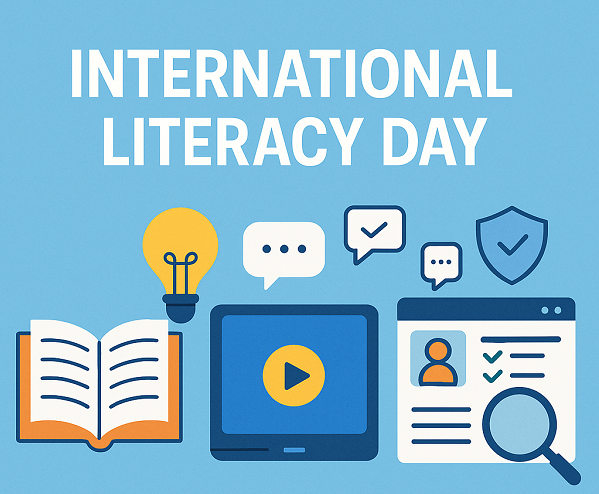
“Education is not only the birthright of every human being but also the weapon of social change.”
Dr B. R. Ambedkar’s words carry even more weight today as we celebrate International Literacy Day 2025. This year’s theme, “Promoting literacy in the digital era,” reminds us that literacy no longer begins and ends with pen and paper.
A Journey Worth Remembering
India’s literacy story is one of resilience. In 1951, only 16 out of every 100 Indians could read and write. By 2022, that number had climbed to 77.7 per cent. The Right to Education Act of 2009 opened the doors of schools to millions who might otherwise have been left behind. Yet numbers alone do not tell the full story. Getting children into classrooms was only the first battle. The bigger challenge lies in what and how they learn.
Literacy in the Age of Screens
In a world where screens dominate, literacy now means much more than decoding text. It is about being able to access, understand, evaluate, and create digital content in safe and responsible ways. A teenager scrolling endlessly on social media might look “digitally literate,” but true literacy asks whether that teenager can spot a fake news story, respond appropriately to cyberbullying, or understand that their digital footprint will outlive their mood.
The dangers are real. A BBC feature this year explained how adolescence itself makes young people more vulnerable to online manipulation because their brains are wired for risk-taking and peer approval. Platforms exploit these vulnerabilities with algorithms that feed them echo chambers of extreme views and endless scrolling loops. What looks like harmless entertainment often becomes a powerful shaper of values and identities.
At the same time, teenagers are seeking comfort in unexpected places. An ETV Bharat report revealed that many Indian students now turn to AI chatbots for emotional support. Experts worry that without proper guidance, children may start to trust technology more than people, with little understanding of how these systems work or what agendas they may carry. Digital literacy, therefore, is not simply about knowing how to use a device but about learning how to navigate relationships, trust, and choices in a digital-first world.
The Missing Lessons
Alongside digital literacy, we are also missing some of the most practical lessons of life. An India Today feature pointed out that while our students can solve complex equations, very few know how to calculate tax, understand savings, or even read the fine print of a bank loan. In an age of instant loans and digital payment apps, this lack of financial literacy is dangerous. Children should be learning how to protect themselves from online scams, how to recognise manipulative advertisements, and how to make decisions that safeguard their futures.
The truth is, literacy today is incomplete without responsibility. Children may be skilled at clicking, posting, or streaming, but if they do not know what to believe, what to share, and what to ignore, they are vulnerable. Civic sense must become part of the digital literacy package. How we behave online is not separate from who we are as citizens. Words can wound, misinformation can destabilise, and silence in the face of bullying can be as harmful as participation.
For India to truly lead in the digital era, we must expand our vision of education. That means increasing education budgets, investing in teacher training, and ensuring that technology-enabled learning does not just deliver content but builds character. It also means recognising that the skills of tomorrow include empathy, resilience, financial wisdom, and civic responsibility.
Ambedkar reminded us that education is the most powerful weapon of social change. In 2025, that weapon is not only the ability to read books but the ability to read the world. Literacy is about survival, about belonging, and about preparing our children not just to live in the digital era but to shape it responsibly.
International Literacy Day should remind us that while we have come far since 1951, the journey is far from over. The future depends on whether we can teach the next generation not only to read and write, but also to choose wisely, live responsibly, and stand tall as citizens of a digital world.
Edutainment
Weaving Social-Emotional Learning into the Curriculum
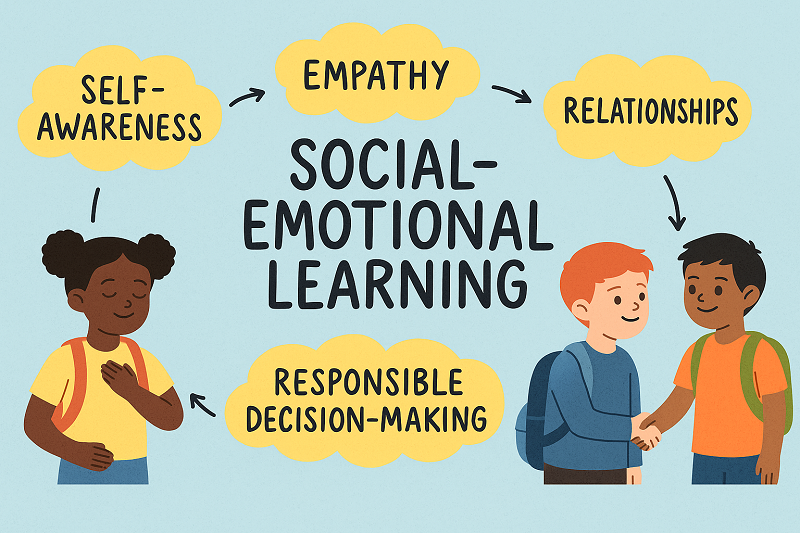
When we think of school learning, the first things that come to mind are math equations, science experiments, history timelines, and grammar rules. But education isn’t only about academic skills—it’s also about preparing students for life. This is where Social-Emotional Learning (SEL) steps in, transforming classrooms into spaces that nurture not just minds, but hearts.
What is Social-Emotional Learning?
Social-Emotional Learning is the process through which students acquire and apply skills to:
- Understand and manage emotions
- Build healthy relationships
- Show empathy for others
- Make responsible decisions
- Set and achieve positive goals
In simpler terms, SEL is about helping students become self-aware, emotionally intelligent, and socially responsible.
Why Should SEL Be Part of the Curriculum?
For decades, education focused on the “3 Rs” – reading, writing, and arithmetic. Today, we know that EQ (Emotional Quotient) can be just as important as IQ. Studies show that integrating SEL into the curriculum leads to:
- Improved academic performance
- Reduced stress and anxiety
- Fewer behavioural issues
- Stronger peer relationships
- Better conflict-resolution skills
A student who learns how to manage frustration or work well in a team is more likely to thrive both inside and outside the classroom.
How SEL Fits into Different Subjects
- Language and Literature – Discussing characters’ feelings in a story builds empathy and perspective-taking.
- Science – Group experiments encourage collaboration and respectful communication.
- Mathematics – Problem-solving in pairs or teams fosters patience and perseverance.
- Social Studies – Exploring diverse cultures promotes acceptance and respect.
Practical Ways to Embed SEL into Curriculum
- Morning check-ins: A quick emotional “temperature check” helps teachers understand students’ moods.
- Role-play activities: Encourage students to act out scenarios that require empathy or problem-solving.
- Collaborative projects: Promote teamwork, negotiation, and leadership skills.
- Mindfulness breaks: Simple breathing exercises can improve focus and emotional balance.
When SEL is woven into lesson plans, we move from an education system that simply imparts knowledge to one that shapes compassionate, resilient, and adaptable individuals. In a world that is constantly changing, these life skills are not optional—they are essential.
Final Sum-Up
Social-Emotional Learning doesn’t replace academic learning; it enriches it. By combining books with empathy, logic with kindness, and grades with grit, we can prepare students not just for exams, but for life.
This article is authored by-

Ranjith P C, Head- Curriculum Excellence, TVS Education
Education
Education with Purpose: Shaping Responsible Learners for a Better Tomorrow
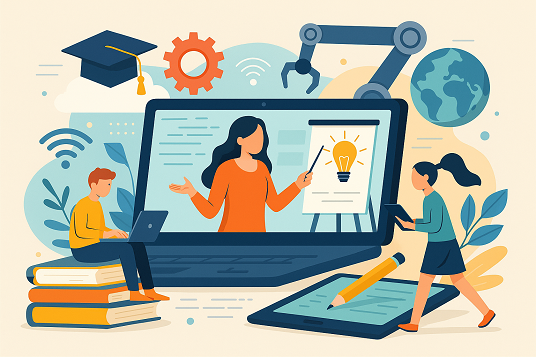
Education is the wellspring of civilization. It begets arts, culture, sciences, and polity to create a society oriented towards discovery and development. Through the ages, education has evolved to meet the needs of the times, and presently, it has reached an inflection point. The inexorable advancement of technology, abundance of information, pressing societal challenges and climate crisis have compelled educators to re-imagine education for the 21st century.
With the rapid prevalence of generative artificial intelligence, the question rightly being asked is: “What should we teach children when almost all answers can be readily had from AI?” The education of tomorrow would reward critical thinking over knowledge. That is what our focus and onus as educators should be. Children, being the digital natives, are more inclined to leverage the full potential of technology. It is up to us to help them realize and understand that AI should augment – not replace – HI (human intelligence). To think critically, to understand, to create and innovate should always be the preserve of humans. The ‘human-first, tech forward’ approach should become the cornerstone of education, going ahead.
An equal focus has to be on building skills, values and attitudes to address the most pressing problems of the world today. The World Economic Forum’s Education 4.0 framework underscores the importance of nurturing global citizenship, environmental stewardship, growth mindset, adaptability, civic responsibility, socio-emotional awareness, empathy, and kindness. The challenge is to find ways to model these into learners’ personality, traits and behaviours.
Re-designing curricula, taking learning beyond classrooms, and reforming assessments could be the answer. Marks and grades can only be one of the benchmarks of learning. Time has come for us to consider skill-based and value-based assessments to reflect a learner’s competence and character. Here, the National Education Policy 2020 – with its progressive vision – can be the guiding compass to steer us towards a more holistic and value-driven paradigm of learning. Institutions should also harness technology to create personalized learning pathways to meet the unique needs of each student.
None of this transformation would be possible without more empowered and enlightened teachers. Progressive institutions are already taking a lead in continuous professional development of their teachers and staff. On their part, teachers will have to be open to unlearn and relearn, upskill and reskill to stay abreast of the new pedagogies and technology. They should be adept in delivering personalized learning using data-driven insights and adapt to the new role of facilitators in an ecosystem where student agency is growing increasingly assertive. Schools must actively engage with parents and students to help them understand the need to look beyond grades. Parents must be informed of the changing jobs market and the importance of building durable skills.
Reforms and initiatives are also required at the policy level to attract private capital into an education landscape where private schools are outnumbered by government schools but cater to about half of the total 24.8 crore school-going student population. The potential of public-private partnerships should also be explored to elevate the quality of education in government schools. Digital infrastructure across the nation has to be strengthened to make learning accessible to the last child in the remotest of places. Creation and dissemination of multi-lingual content will enhance inclusivity of learning in the new Bharat.
Today, the education fraternity, governments, and parents need to collaborate to facilitate this transition into Education 4.0. We need to re-envision education as a human development endeavor to create a sustainable future wherein prosperity goes hand-in-hand with people and the planet. Right intentions need to be followed with earnest action. The future will be India’s to claim.
This article is authored by-

Shishir Jaipuria, Chairman, Seth Anandram Jaipuria Group of Educational Institutions
Education
Empathy as a 21st-Century Competency: Developing Emotional Intelligence among Students

Within the conversation of future-ready education, empathy has moved from being characterized as a “soft” individual characteristic to being identified as an essential social and cognitive ability. Frameworks such as the OECD Learning Compass 2030, UNESCO’s Global Citizenship Education, and the World Economic Forum’s Future of Jobs Report put empathy at the forefront of skills required to succeed in an uncertain, interdependent world.
From Emotion to Competence
Empathy is confused with sympathy, yet they are essentially different. Empathy is an active, cognitive, and affective process, the capacity to grasp another’s emotional situation, comprehend it in context, and react creatively. Neuroscientific research, for example, by Decety and Jackson (2004), illustrates that empathy engages both the limbic system, which controls emotional resonance, and the prefrontal cortex, which controls perspective-taking and rational reaction. Briefly put, empathy does not just mean “feeling with someone”, it means thinking with feeling, where intellect and emotion unite to shape behaviour and decision-making.
Early Childhood (Ages 3–6) – Seeds of Empathy
At the age of three to six years, children in early childhood start showing the beginning signs of empathy by what is termed as “emotional contagion” by psychologists. They tend to cry when others cry or smile when others smile due to the observed emotional state. By the time they are four or five years old, according to research conducted by Zahn-Waxler et al. (1992), children start showing other-oriented concern like sharing, comforting, or embracing a fellow child who looks distressed. Empathy at this age is still primarily affect-based; children sympathize with others but possess little ability to grasp intricate frames of mind. Teachers can cultivate these early roots of empathy through narrative, role-playing, and guided social-emotional education that offer the vocabulary and structure to make sense of emotions.
Middle Childhood (Ages 7–12) – Perspective-Taking Develops
By middle childhood, around ages seven to twelve, empathy is increasingly cognitively complex. They start to understand that people might think and feel differently from themselves, an ability outlined in Selman’s stages of perspective-taking. Peer relationships are increasingly important at this stage, and children increasingly become sensitive to fairness, belonging, and group membership. According to research by Eisenberg et al. (2010), this is a critical window for the instruction of moral reasoning in addition to empathy. Cooperative learning activities, peer mediation programs, and community service offer children meaningful opportunities for empathy extension from intimate friendships to include strangers and even members of out-groups.
Adolescence (Ages 13–18) – Abstract and Global Empathy
An important stage in the development of empathy is adolescence, which lasts from the ages of thirteen to eighteen. Adolescents gain the ability to relate to abstract ideas such as global emergencies, injustice, and inequality. According to Blakemore’s (2018) neuroimaging research, adolescent brain regions involved in identity formation and social cognition are more active. However, hormonal changes and heightened self-awareness are also hallmarks of adolescence, which makes young people more reflective. Schools can assist in this area by offering intentional opportunities for teenagers to develop empathy, such as discussion forums that foster critical thinking, service-learning initiatives that are linked to current events, and cross-cultural interactions that extend their horizons. Adolescents can use these activities to channel their growing empathy into constructive civic engagement.
Young Adulthood (18+) – Empathy as Leadership Skill
Empathy matures during late adolescence and young adulthood as a skill that is intricately linked with emotional control, leadership, and ethical choice. Now, it transcends interpersonal interaction to become the hallmark of effective leadership. More employers are realizing this; a 2022 LinkedIn survey indicated that 78 percent of employers view emotional intelligence as equally or even more important than technical skills. Universities and workplaces increasingly require such competencies, and schools can prepare young adults through leadership programs, mentorship positions, and reflective practices that instil empathy in civic and professional life.
Beyond Awareness to Application
While awareness of empathy is valuable, its real utility comes from practice. Schools need to inculcate empathy not only in coursework but in lived experience. Narrative immersion in literature, film, and even virtual reality allows students to step into other people’s shoes. Structured ethical discussions in dialogic classrooms offer the space for respectful disagreement and deeper understanding. Cross-age mentorship, where older students mentor younger ones, develops a sense of responsibility while strengthening bonds across age. Service-learning, when paired with structured reflection, develops empathy into action. Even cutting-edge tools that offer emotional analytics while working in a team can assist students in self-evaluating and managing their emotions, turning empathy into a mindful and deliberate process instead of an automatic reaction.
The 21st-Century Payoff
The dividend of developing empathy in education is significant. In a world of artificial intelligence, empathy is one differentiator that makes us uniquely human. The World Economic Forum (2025) identifies emotional intelligence, empathy, and collaboration as among the future workforce’s top ten skills. Students who can read emotional team dynamics, negotiate across cultures, and build authentic relationships are not just more hireable but indeed invaluable in a fast-paced professional landscape.
Empathy is not a mushy virtue but a developmental skill that develops systematically throughout childhood and adolescence. Schools that deliberately foster it are not just creating smarter students; they are raising wiser, kinder citizens who can lead with compassion and resilience. Empathy is a moral and practical necessity for 21st-century education, the bridge that unites emotional intelligence and the needs of an interconnected world.
(This article is authored by Dr. Silpi Sahoo, Chairperson, SAI International Education Group)
Education
Math Meets Machine: How AI Is Revolutionising Classroom Learning

In a world where algorithms power everything from our social media feeds to self-driving cars, it’s no surprise that Artificial Intelligence (AI) is transforming one of the oldest pillars of education—math learning in the classroom. Once confined to textbooks and chalkboards, math instruction is now getting a high-tech upgrade, ushering in a new era of personalised, engaging, and data-driven learning.
Cracking the Code: Why Math Needs a Makeover?
Let’s face the fact that many students see math as abstract, intimidating, or just plain boring. Traditional classroom approaches often take a one-size-fits-all route, leaving behind both the struggling learner and the gifted problem-solver. This is where AI steps in, not to replace the teacher, but to empower them with tools that adapt to each student’s pace, gaps, and style.
Enter AI: The Digital Math Mentor
Imagine a classroom where a student struggling with fractions gets instant, visual explanations tailored to their exact misunderstanding. At the same time, another who excels in geometry is offered advanced challenges to stretch their thinking. AI platforms are doing just that. They use real-time data to analyse student responses, detect patterns of error, and provide feedback that feels like one-on-one tutoring.
Far from replacing educators, AI acts as a powerful teaching assistant. Teachers can use AI dashboards to spot who needs extra help, where the class is lagging, or what concepts need reteaching without spending hours on manual assessments. This frees up more time for creativity, collaboration, and real-life math applications that bring numbers to life.
AI also allows classrooms to become more inclusive and equitable. Language barriers? AI can offer multilingual support. Visual learners? Dynamic simulations and interactive tools adapt seamlessly. Students with special needs? Personalized pacing ensures no one falls through the cracks.
What’s Next? The Future of Math + AI
As AI grows more sophisticated, so does its potential in math classrooms. Think AI-generated practice problems based on local news, gamified learning paths that turn algebra into an adventure, or virtual tutors available 24/7 for homework help.
But with great power comes great responsibility. Educators, parents, and developers must ensure that AI tools remain ethical, transparent, and supportive, not controlling or biased.
Math education is no longer just about memorising formulas or solving problems on paper. In the AI-powered classroom, it’s about curiosity, connection, and confidence. With the right blend of technology and teaching, we’re not just raising better mathematicians but combining critical thinking with the subject for a world powered by data and driven by ideas.
This article is authored by-

Ranjith P C, Head Curriculum Excellence, TVS Education
-

 Education3 months ago
Education3 months agoDharav Utsav to Celebrate Rajasthan’s Cultural Heritage and Local Talent
-
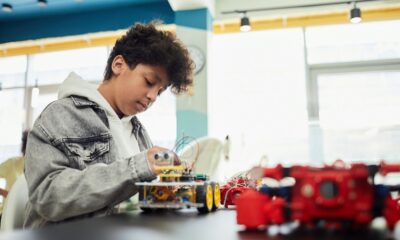
 Education3 months ago
Education3 months agoBeyond the Syllabus: School Teachers’ Insights on Project-Based Learning
-
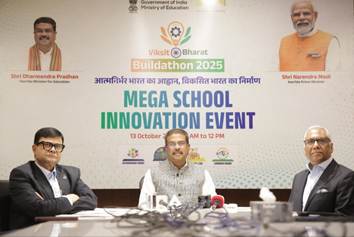
 Education3 months ago
Education3 months agoOver 3 Lakh Schools Join Hands for India’s Largest-Ever Innovation Challenge: Viksit Bharat Buildathon 2025
-

 Education3 months ago
Education3 months agoAI to Become a Core Subject from Class 3: India’s Big Leap Toward a Future-Ready Generation
-

 Education3 months ago
Education3 months agoOver 1 Lakh Single-Teacher Schools Educate 33 Lakh Students Across India: MoE Data
-

 Education3 months ago
Education3 months agoHow to Build Better Parent-Teacher Communication
-

 Inspiration2 months ago
Inspiration2 months agoUmeed: A Ray of Hope for Better Tomorrow
-
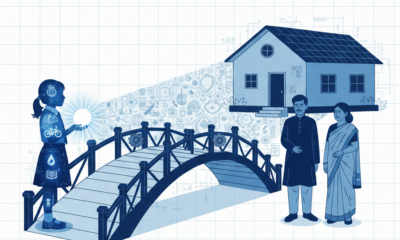
 Knowledge1 week ago
Knowledge1 week agoBuilding a Healthier India: Why School Health Programs Are Essential
-
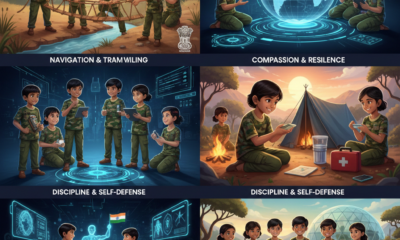
 Education1 week ago
Education1 week agoWhat the Indian Army Teaches Our Children Beyond Textbooks
-

 Inspiration1 week ago
Inspiration1 week agoBefore the Nobel, There Was a Teacher



